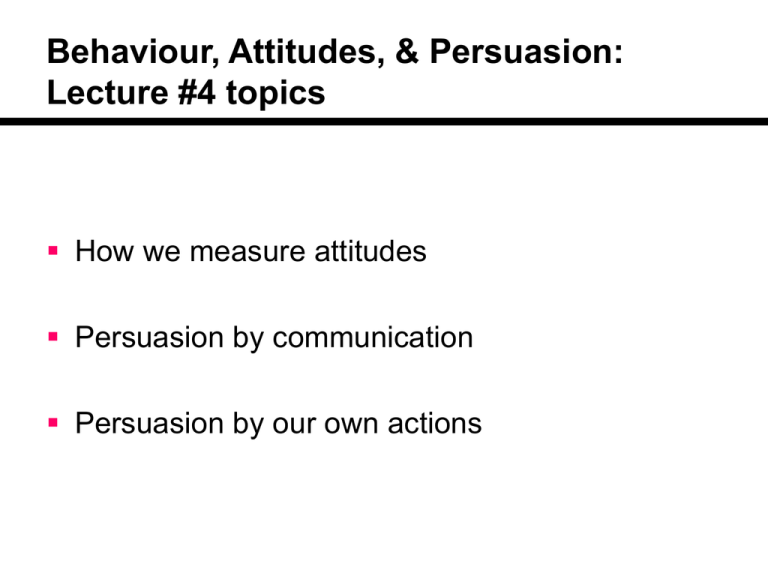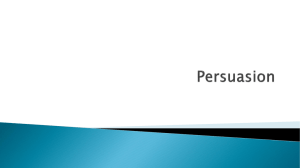Persuasion
advertisement

Behaviour, Attitudes, & Persuasion: Lecture #4 topics How we measure attitudes Persuasion by communication Persuasion by our own actions Measuring attitudes (my nephew, Zachary) Measuring attitudes attitude: positive, negative, or mixed reactions to people, objects or ideas attitude formation is _________ & often _________ attitudes let us judge quickly without much thought Measuring attitudes self-report measures: agreement with statements using multiple-point scales question _________ may bias responses vulnerable to social desirability biases one solution: _________ Measuring attitudes Implicit Association Test (IAT): taps implicit (_________) attitudes we hold reaction time test measuring how quickly you associate different concepts with “_________” and “_________” Measuring attitudes GOOD (press ‘e’) BAD (press ‘i’) Measuring attitudes GOOD (press ‘e’) BAD (press ‘i’) Linking attitudes & behaviour attitudes predict behaviour when: attitudes _________ correspond to the behaviour attitudes are _________ strong attitudes develop through: _________ _________ _________ Persuasion by communication Persuasion by communication dual-process model of persuasion (Petty & Cacioppo, 1986): PERSUASIVE MESSAGE CENTRAL ROUTE _________ focus on _________ of arguments PERIPHERAL ROUTE focus on _________ cues reliance on _________ Persuasion by communication “The receptive ability of the masses is very limited, their understanding small; on the other hand, they have a great power of forgetting.” —Adolf Hitler Persuasion by communication ROUTE SELECTION source speaks well important message we care about the information _________ ROUTE source speaks too fast unimportant message we’re not interested in the information _________ ROUTE Persuasion by communication a good source is: _________ similar to the audience physically attractive (Chaiken, 1979) _________ competent (smart, well-spoken, has credentials) trustworthy (honest) Persuasion by communication WOULD YOU BUY A PRODUCT ENDORSED BY BRITNEY SPEARS? soft drinks roller skates milk cameras Persuasion by communication the sleeper effect: when a message from a _________ source _________ in persuasiveness over time you immediately _________ the message, but then you eventually _________ the message from the source Persuasion by communication 3 factors influencing message impact: message length _________ messages seem more valid & factual presentation order primacy vs. recency effects which is better? it depends on _________ (Miller & Campbell, 1959). Persuasion by communication Miller & Campbell (1959): GROUP 1 message 1 message 2 (1 week) decision GROUP 2 message 1 (1 week) message 2 decision _________ EFFECT _________ EFFECT Persuasion by communication message discrepancy extreme vs. cautious positions? _________ discrepancy is necessary for persuasion to occur Persuasion by communication FEAR APPEALS http://www.youtube.com/watch?v=80fux1DE1kQ&mode=related&search= (courtesy: Cancer Institute NSW, Australia) Persuasion by communication Persuasion by communication fear appeals ARE persuasive: they feed on our vulnerabilities by grabbing our attention with graphic images …but they only work if they _________ about how to cope with the danger Persuasion by communication positive emotions are also persuasive: good moods cognitively _________ us they activate the “lazy” _________ route to attitude change we are motivated to maintain our good moods so we don’t think too critically about anything Persuasion by communication HOW DO WE RESIST PERSUASION? attitude inoculation: exposure to _________ opinions reinforces existing attitudes e.g., Freedman & Sears (1965) “driving” study psychological reactance: motivation to protect our ability to think, act, & feel _________ triggered when someone tries to _________ us Persuasion by our own actions ROLE PLAYING Patty Hearst Phil Zimbardo Persuasion by our own actions foot-in-the-door phenomenon: compliance with a _________ request after agreeing to a _________ one e.g., Freedman & Fraser (1966) “drive carefully” study low-ball technique: committing to a superficially attractive proposition before hidden costs are revealed popular with _________ Persuasion by our own actions cognitive dissonance theory (Festinger, 1957): _________ state of _________ resulting from attitude-behaviour _________ occurs when attitude-discrepant behaviour is committed: _________ _________ Persuasion by our own actions REDUCING DISSONANCE: STRATEGY EXAMPLE Change perception of behaviour “I didn’t eat a LOT of ice cream” Add consonant cognitions “Ice cream is a good source of calcium” Minimize importance of conflict “Life’s too short to worry about weight” Reduce perceived choice “The ice cream would have gone bad” Change attitude to match behaviour “I don’t need to be on a diet anyway” Persuasion by our own actions Festinger & Carlsmith (1959): Justifying our actions Enjoyment of study HIGH LOW No Lie $20 Lie Condition $1 Lie Persuasion by our own actions Aronson & Mills (1959): Justifying our effort Liking of discussion group HIGH LOW No Initiation Mild Initiation Condition Severe Initiation Persuasion by our own actions Justifying our choices George: handsome brings me flowers chews with mouth open Brad: handsome funny pessimistic Persuasion by our own actions Brehm (1956): Justifying our choices PRE-CHOICE RATINGS POST-CHOICE RATINGS Product ratings HIGH LOW Toaster Radio Toaster Radio Persuasion by our own actions ALTERNATIVE EXPLANATIONS FOR DISSONANCE EFFECTS self-perception theory (Bem, 1965): inference of attitudes through _________ attitude change is “_________” process evidence: neutral observers who read Festinger & Carlsmith’s procedure generated _________ results as original participants Persuasion by our own actions self-esteem theory (Aronson, 1999): dissonance threatens our _________ selfconcepts, leading to _________ self-esteem _________ self-esteem leads to attitude change self-affirmation theory (Steele, 1988): self-affirmation: reminders of our _________ if dissonance threatens our self-concepts, selfaffirmation should _________ attitude change Persuasion by our own actions Steele, Spencer, & Lynch (1993): Justifying our choices EGO AFFIRMED EGO THREATENED CD1 CD1 Post-choice CD ratings HIGH LOW CD2 CD2




